An Hourglass-Shaped Wireless and Passive Magnetoelastic Sensor with an Improved Frequency Sensitivity for Remote Strain Measurements
Abstract
1. Introduction
2. Materials and Methods
2.1. Materials
2.2. Structure of the Proposed HSMS
2.3. Finite Element Method (FEM)
2.4. The Experiment Setup
3. Results and Discussion
4. Conclusions
Author Contributions
Funding
Conflicts of Interest
References
- Chen, J.; Li, J.; Xu, L. Highly integrated MEMS magnetic sensor based on GMI effect of amorphous wire. Micromachines 2019, 10, 237. [Google Scholar] [CrossRef] [PubMed]
- Sun, S.; Zhang, S.; Zhang, B.; Ding, W. Magnetization and giant magnetoimpedance effect of Co-rich microwires under different driven currents. J. Sensors 2016, 2016, 6465235. [Google Scholar] [CrossRef]
- Gazda, P.; Nowicki, M.; Szewczyk, R. Comparison of stress-impedance effect in amorphous ribbons with positive and negative magnetostriction. Materials 2019, 12, 275. [Google Scholar] [CrossRef] [PubMed]
- Nowicki, M.; Gazda, P.; Szewczyk, R.; Marusenkov, A.; Nosenko, A.; Kyrylchuk, V. Strain dependence of hysteretic Giant Magnetoimpedance effect in Co-based amorphous ribbon. Materials 2019, 12, 2110. [Google Scholar] [CrossRef]
- Torrejón, J.; Badini, G.; Pirota, K.; Vázquez, M. Modified small angle magnetization rotation method in multilayer magnetic microwires. J. Magn. Magn. Mater. 2007, 316, 575–578. [Google Scholar] [CrossRef]
- Nowicki, M. Tensductor—Amorphous alloy based magnetoelastic tensile force sensor. Sensors 2018, 18, 4420. [Google Scholar] [CrossRef]
- Lopes, A.C.; Sagasti, A.; Lasheras, A.; Muto, V.; Gutiérrez, J.; Kouzoudis, D.; Barandiarán, J.M. Accurate determination of the Q quality factor in magnetoelastic resonant platforms for advanced biological detection. Sensors 2018, 18, 887. [Google Scholar] [CrossRef]
- Thiruvenkatanathan, P.; Yan, J.; Woodhouse, J.; Aziz, A.; Seshia, A.A. Ultrasensitive mode-localized mass sensor with electrically tunable parametric sensitivity. Appl. Phys. Lett. 2010, 96, 81913–81915. [Google Scholar] [CrossRef]
- Saiz, P.G.; Gandia, D.; Lasheras, A.; Sagasti, A.; Quintana, I.; Fdez-Gubieda, M.L.; Gutiérrez, J.; Arriortua, M.I.; Lopes, A.C. Enhanced mass sensitivity in novel magnetoelastic resonators geometries for advanced detection systems. Sens. Actuators B Chem. 2019, 296, 126612. [Google Scholar] [CrossRef]
- Tan, E.L.; Derouin, A.J.; Ong, K.G. Magnetoelastic-harmonic stress sensors with tunable sensitivity. IEEE Sens. J. 2012, 12, 1878–1883. [Google Scholar] [CrossRef]
- Zhang, K.; Zhang, L.; Chai, Y. Mass load distribution dependence of mass sensitivity of magnetoelastic sensors under different resonance modes. Sensors 2015, 15, 20267–20278. [Google Scholar] [CrossRef] [PubMed]
- Grimes, C.A.; Roy, S.C.; Rani, S.; Cai, Q. Theory, instrumentation and applications of magnetoelastic resonance sensors: A review. Sensors 2011, 11, 2809–2844. [Google Scholar] [CrossRef] [PubMed]
- Grimes, C.A.; Mungle, C.S.; Zeng, K.; Jain, M.K.; Dreschel, W.R.; Paulose, M.; Ong, K.G. Wireless Magnetoelastic Resonance Sensors: A Critical Review. Sensors 2002, 2, 294–313. [Google Scholar] [CrossRef]
- DeMartini, B.E.; Rhoads, J.F.; Zielke, M.A.; Owen, K.G.; Shaw, S.W.; Turner, K.L. A single input-single output coupled microresonator array for the detection and identification of multiple analytes. Appl. Phys. Lett. 2008, 93, 1–4. [Google Scholar] [CrossRef]
- Sagasti, A.; Gutiérrez, J.; Lasheras, A.; Barandiarán, J.M. Size Dependence of the Magnetoelastic Properties of Metallic Glasses for Actuation Applications. Sensors 2019, 19, 4296. [Google Scholar] [CrossRef]
- Ren, L.; Yu, K.; Tan, Y. Monitoring and Assessing the Degradation Rate of Magnesium-Based Artificial Bone In Vitro Using a Wireless Magnetoelastic Sensor. Sensors 2018, 18, 3066. [Google Scholar] [CrossRef]
- Tan, Y.; Hu, J.; Ren, L.; Zhu, J.; Yang, J.; Liu, D. Di A Passive and Wireless Sensor for Bone Plate Strain Monitoring. Sensors 2017, 17, 2635. [Google Scholar]
- Spletzer, M.; Raman, A.; Sumali, H.; Sullivan, J.P. Highly sensitive mass detection and identification using vibration localization in coupled microcantilever arrays. Appl. Phys. Lett. 2008, 92, 2006–2009. [Google Scholar] [CrossRef]
- Herbko, M. Microstrip Patch Strain Sensor Miniaturization Using Sierpinski Curve Fractal Geometry. Sensors 2019, 19, 3989. [Google Scholar] [CrossRef]
- Grimes, C.A.; Stoyanov, P.G.; Kouzoudis, D.; Ong, K.G. Remote query pressure measurement using magnetoelastic sensors. Rev. Sci. Instrum. 1999, 70, 4711–4714. [Google Scholar] [CrossRef]
- De Rouin, A.; Pacella, N.; Zhao, C.; An, K.N.; Ong, K.G.; Karipott, S.S.; Veetil, P.M.; Nelson, B.D.; Guldberg, R.E.; Ong, K.G.; et al. A wireless sensor for real-time monitoring of tensile force on sutured wound sites. IEEE Trans. Biomed. Eng. 2016, 63, 1665–1671. [Google Scholar] [CrossRef] [PubMed]
- Trierweiler, S.; Holmes, H.; Pereles, B.; Rajachar, R.; Ong, K.G. Remotely activated, vibrational magnetoelastic array system for controlling cell adhesion. J. Biomed. Sci. Eng. 2013, 06, 478–482. [Google Scholar] [CrossRef][Green Version]
- Pepakayala, V.; Green, S.R.; Gianchandani, Y.B. Passive wireless strain sensors using microfabricated magnetoelastic beam elements. J. Microelectromechanical Syst. 2014, 23, 1374–1382. [Google Scholar] [CrossRef]
- Pepakayala, V.; Green, S.R.; Gianchandani, Y.B. Wireless strain measurement with a micromachined magnetoelastic resonator using ringdown frequency locking. ISSS J. Micro Smart Syst. 2017, 6, 3–13. [Google Scholar] [CrossRef][Green Version]
- Huber, T.; Bergmair, B.; Vogler, C.; Bruckner, F.; Hrkac, G.; Suess, D. Magnetoelastic resonance sensor for remote strain measurements. Appl. Phys. Lett. 2012, 101, 2012–2015. [Google Scholar] [CrossRef]
- Tan, Y.; Zhang, Y.; Ren, L. Energy Harvesting From an Artificial Bone. IEEE Access 2019, 7, 120065–120075. [Google Scholar] [CrossRef]
- Mbengue, S.S.; Buiron, N.; Lanfranchi, V. An anisotropic model for magnetostriction and magnetization computing for noise generation in electric devices. Sensors 2016, 16, 553. [Google Scholar] [CrossRef]
- Zhang, R.; Tejedor, M.I.; Anderson, M.A.; Paulose, M.; Grimes, C.A. Ethylene detection using nanoporous PtTiO2 coatings applied to magnetoelastic thick films. Sensors 2002, 2, 331–338. [Google Scholar] [CrossRef]
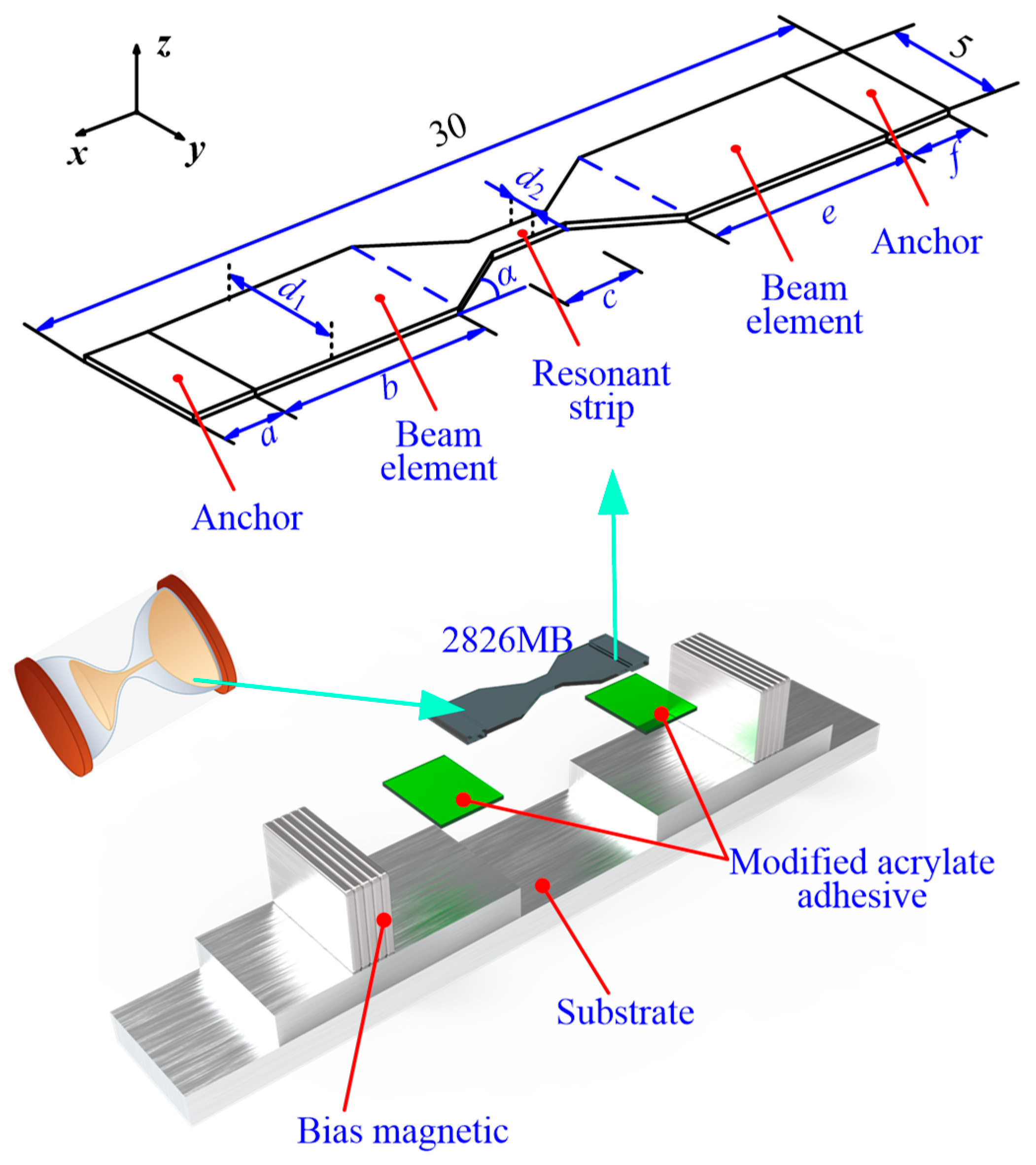
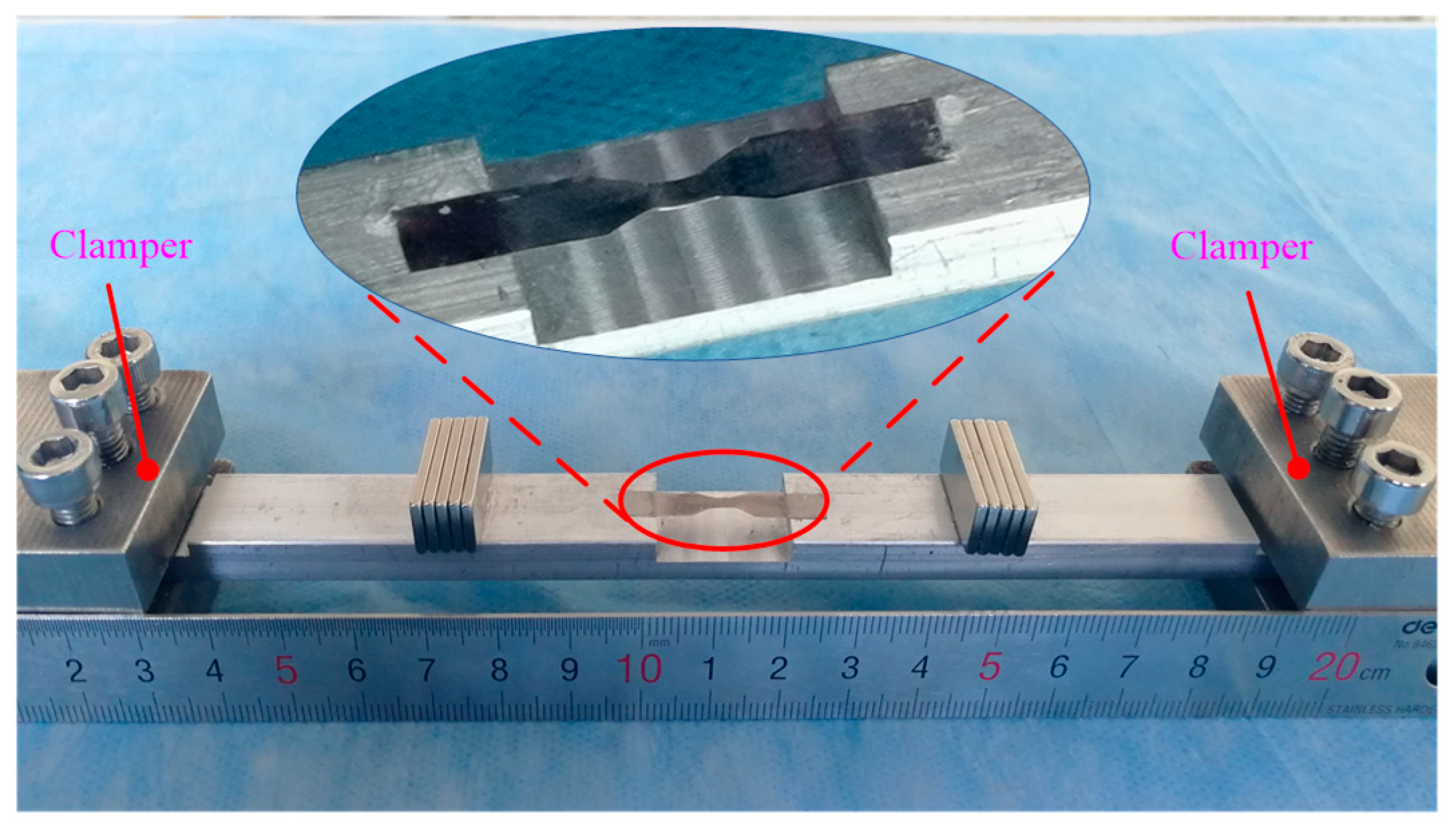

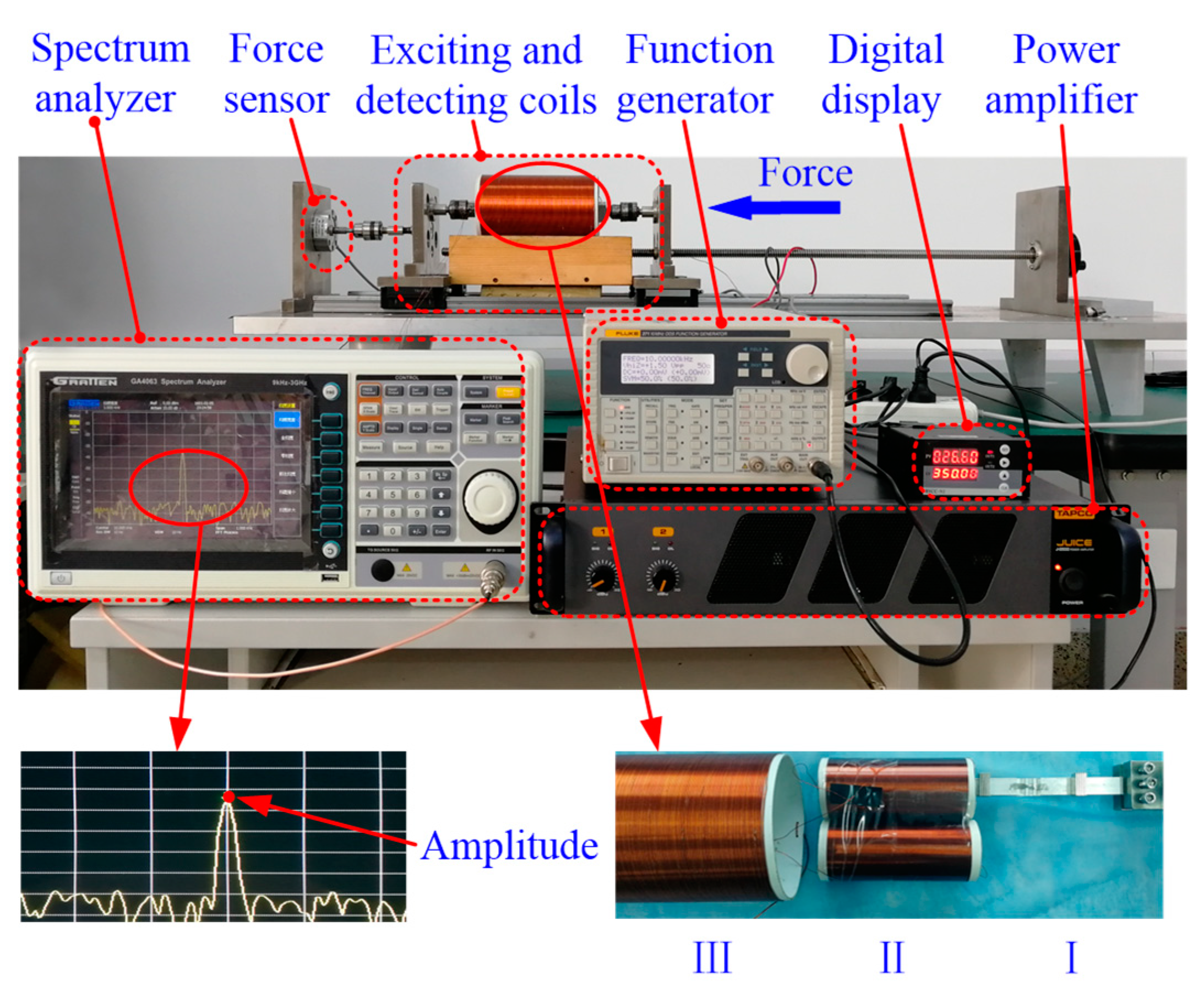
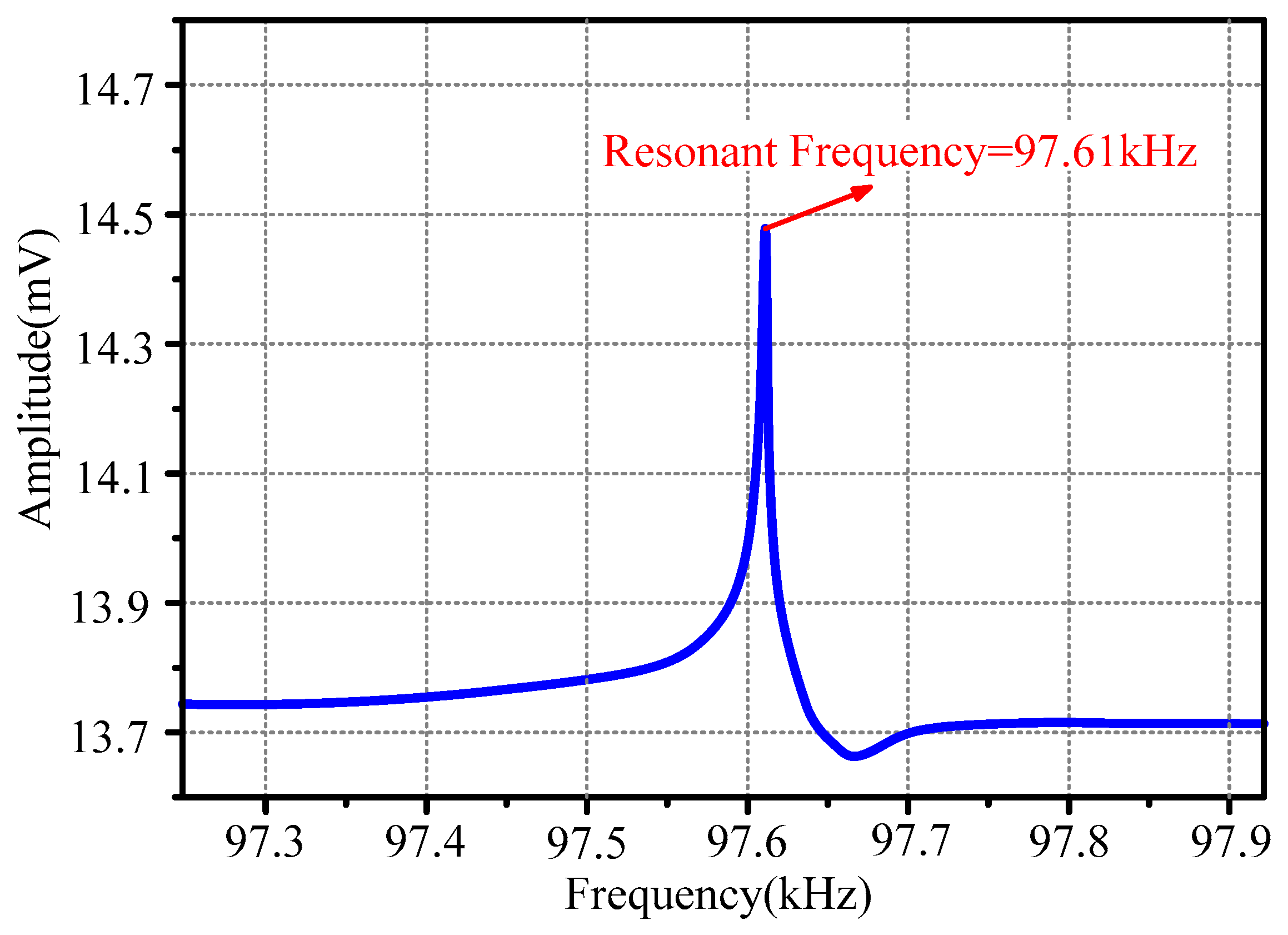

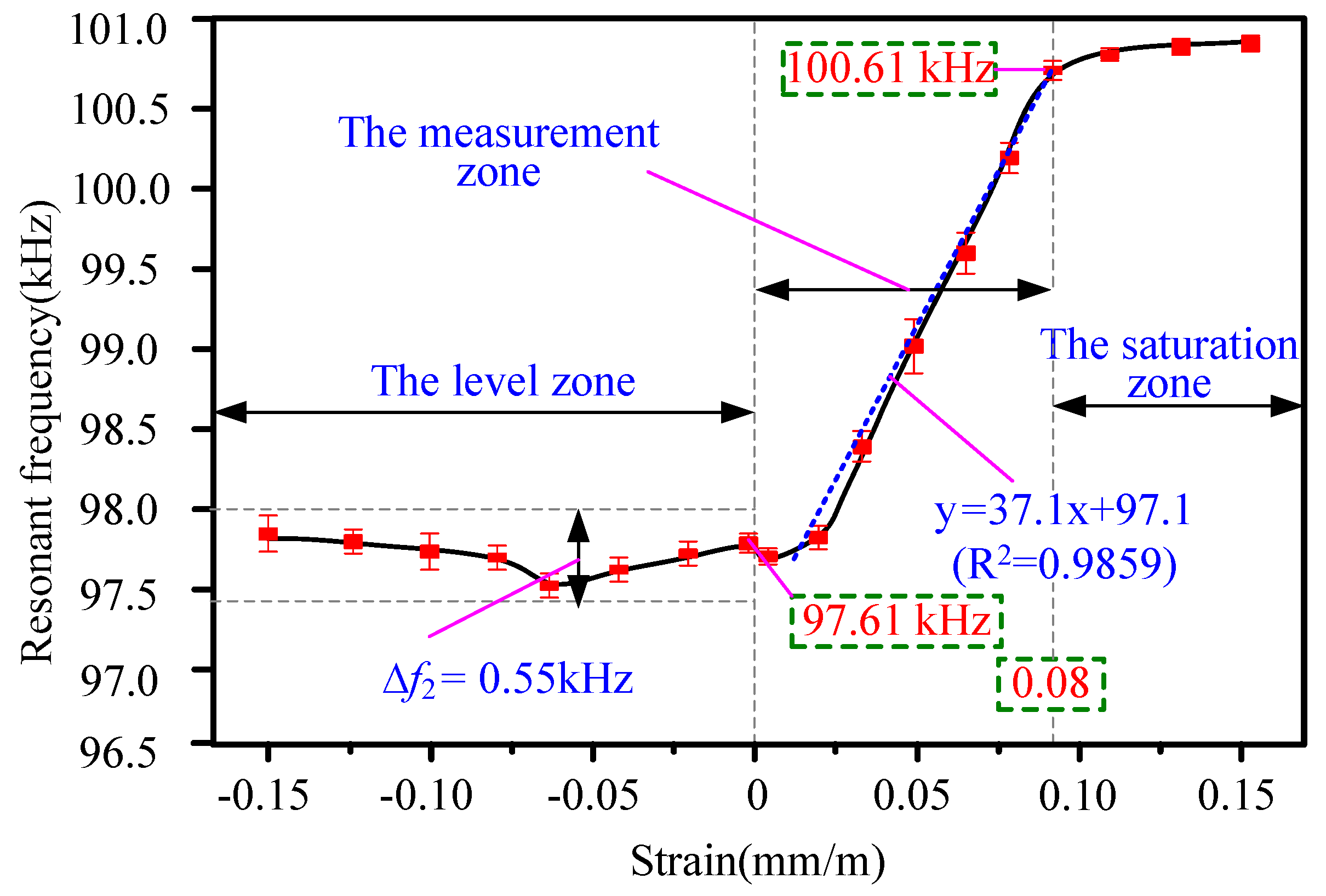
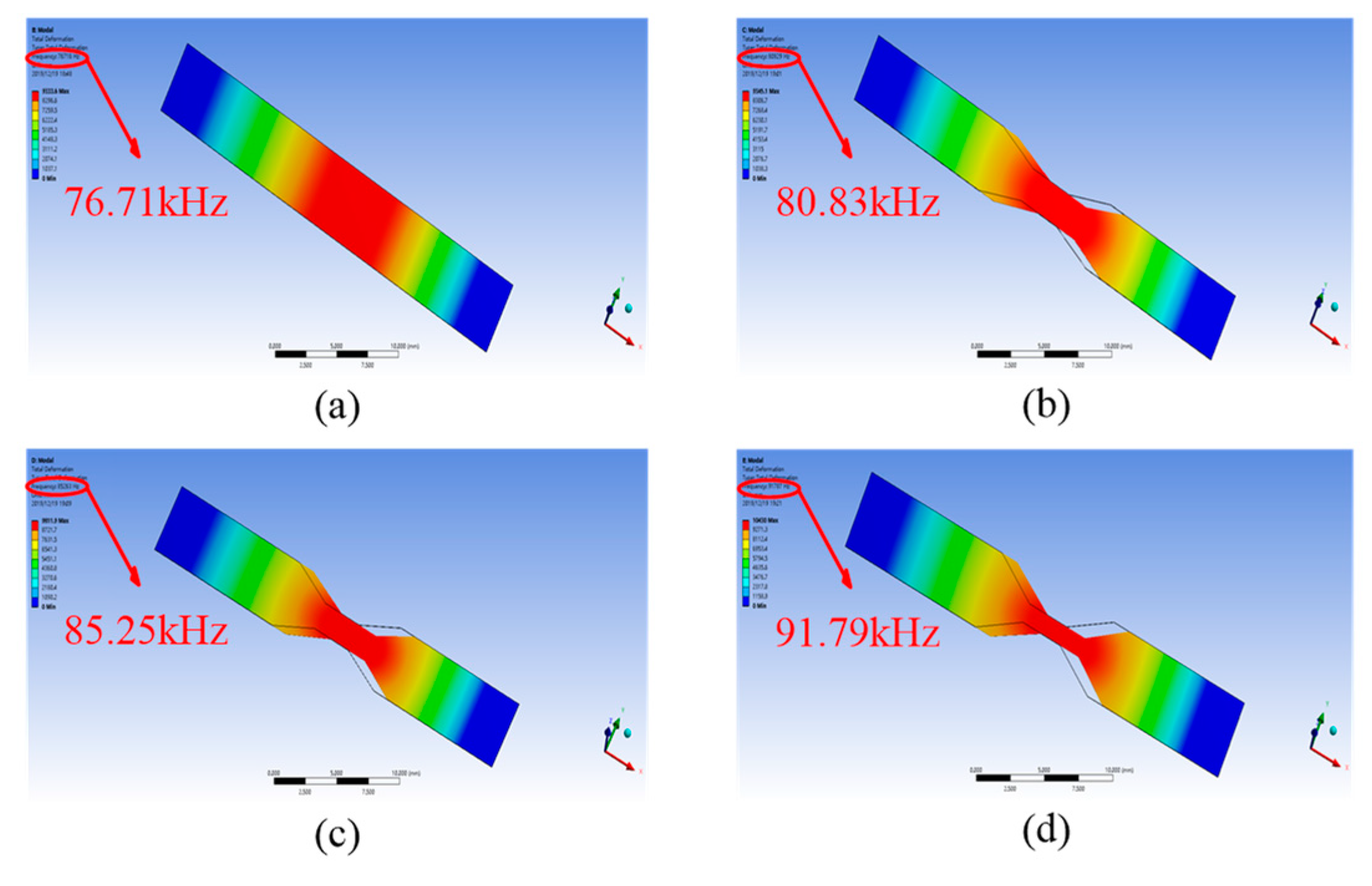
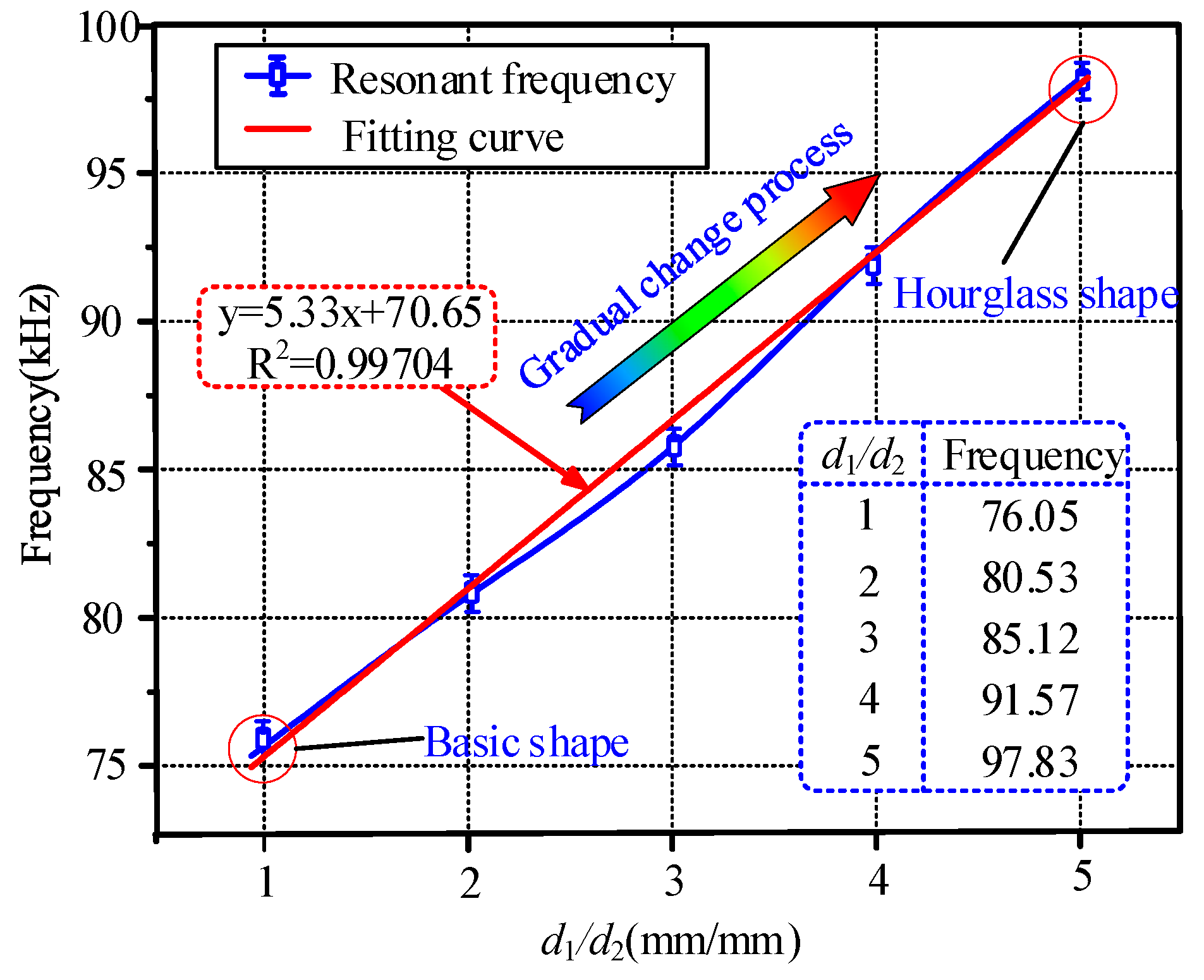

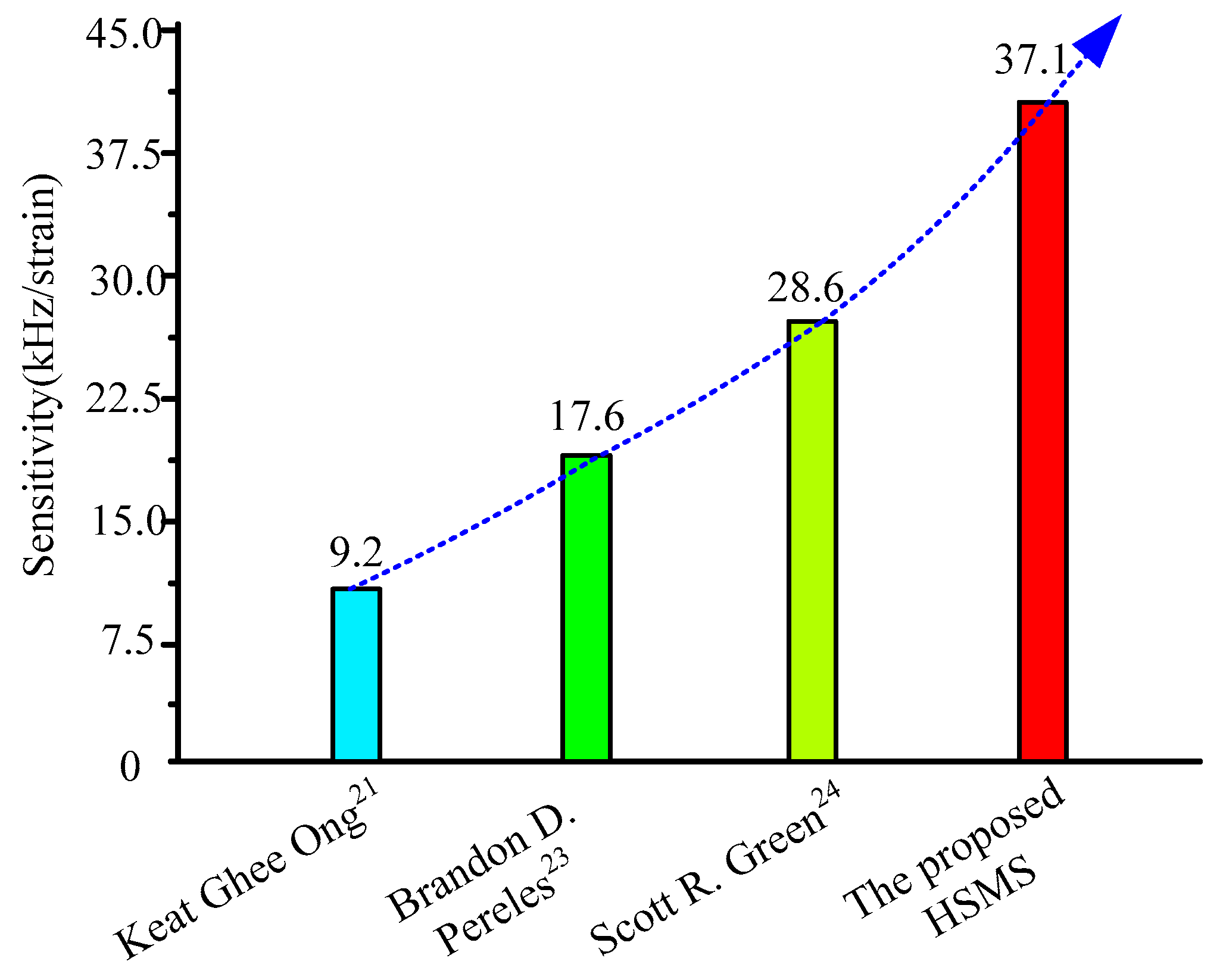
| Magnetic Properties | Physical Properties | ||
|---|---|---|---|
| Saturation Induction (T) | 0.88 | Density (g/cm3) | 7.90 |
| Maximum D.C. Permeability (µ): | Vicker’s Hardness (50 g load) | 740 | |
| Annealed | 800,000 | Elastic Modulus (GPa) | 100–110 |
| As Cast | >50,000 | Tensile Strength (GPa) | 1–2 |
| Saturation Magnetostriction (ppm) | 11.7 | Lamination Factor (%) | >75 |
| Electrical Resistivity (µΩ·cm)s | 138 | Continuous Service Temperature (°C) | 125 |
| Curie Temperature (°C) | 353 | Thermal Expansion (ppm/°C) | 11.7 |
| Magnetoelastic Coupling Factor | 0.98 | Crystallization Temperature (°C) | 410 |
| Symbol | Parameter | Symbol | Parameter |
|---|---|---|---|
| a (mm) | 2.5 | d2 (mm) | 1 |
| b (mm) | 8 | e (mm) | 8 |
| c (mm) | 3 | f (mm) | 2.5 |
| d1 (mm) | 5 | α (°) | 33.69 |
| Item | Properties |
|---|---|
| Length (mm) | 20 |
| Width (mm) | 10 |
| Height (mm) | 2 |
| Mass (g) | 2.5 |
| Magnetic Field Strength (T) | 0.06 |
| Material | Nd-Fe-B Rare Earth |
© 2020 by the authors. Licensee MDPI, Basel, Switzerland. This article is an open access article distributed under the terms and conditions of the Creative Commons Attribution (CC BY) license (http://creativecommons.org/licenses/by/4.0/).
Share and Cite
Ren, L.; Cong, M.; Tan, Y. An Hourglass-Shaped Wireless and Passive Magnetoelastic Sensor with an Improved Frequency Sensitivity for Remote Strain Measurements. Sensors 2020, 20, 359. https://doi.org/10.3390/s20020359
Ren L, Cong M, Tan Y. An Hourglass-Shaped Wireless and Passive Magnetoelastic Sensor with an Improved Frequency Sensitivity for Remote Strain Measurements. Sensors. 2020; 20(2):359. https://doi.org/10.3390/s20020359
Chicago/Turabian StyleRen, Limin, Moyue Cong, and Yisong Tan. 2020. "An Hourglass-Shaped Wireless and Passive Magnetoelastic Sensor with an Improved Frequency Sensitivity for Remote Strain Measurements" Sensors 20, no. 2: 359. https://doi.org/10.3390/s20020359
APA StyleRen, L., Cong, M., & Tan, Y. (2020). An Hourglass-Shaped Wireless and Passive Magnetoelastic Sensor with an Improved Frequency Sensitivity for Remote Strain Measurements. Sensors, 20(2), 359. https://doi.org/10.3390/s20020359





